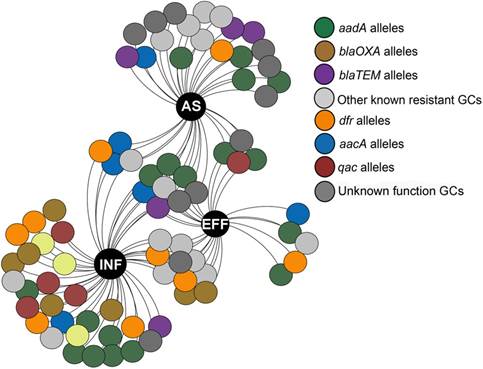

抗生素抗性基因(ARGs)在全球范围内的传播对人类的健康构成严重的威胁。作为一种新型的污染物,抗性基因已成为国际研究的热点。抗性基因的水平转移在推动抗性基因的扩散过程中起着关键的作用。整合子(integron)作为基因捕获系统,可以整合外源基因到基因盒中,是抗性基因水平转移的重要分子元件。长期以来关于抗性基因的研究主要集中于抗性基因总体的丰度和多样性,而很少考虑其所在的位置。位于整合子上面的抗性基因可以通过基因水平转移进入其他的物种包括对人类健康有害的致病菌,因此,对此类抗性基因的研究与人类的健康更加密切。
中国科学院城市环境研究所城市土壤与生物地球化学组朱永官科研团队通过克隆文库和高通量测序分析了不同污水处理厂污水处理过程中一类、二类和三类整合子的丰度,以及相应的基因盒中的抗性基因的多样性。研究发现一类整合子在污水处理中最为常见,而且其丰度随着污水处理进程而降低。在进水中一类整合子基因盒多样性最高,而在污泥中三类整合子基因盒多样性最高。一类整合子中多数基因盒阵列是首次发现。在一类整合子中,大部分基因盒携带抗氨基糖苷类和β-内酰胺类的抗性基因,然而三类整合子基因盒则主要携带β-内酰胺类的抗性基因。此外,在污水处理厂中检测到一个核心的持续存在的抗性基因盒库贯穿于整个污水处理过程,表明这些抗性基因具有更高扩散进入环境的潜在可能性。
该研究成果为研究污水处理对整合子动态变化影响提供了新的视角,强调了监测整合子携带的抗性基因的必要性。相关论文“Impact of wastewatertreatment on the prevalence of integrons and genetic diversity of integron genecassettes”已在线发表于国际微生物学杂志applied and Environmental Microbiology。该论文由博士生安新丽等人完成,通讯作者为研究员苏建强。(来源:中国科学院城市环境研究所)
Impact of wastewater treatment on the prevalence of integrons and genetic diversity of integron gene cassettes
Abstract The integron platform allows the acquisition, expression, and dissemination of antibiotic resistance genes within gene cassettes. Wastewater treatment plants (WWTPs) contain abundant resistance genes; however, knowledge about the impacts of wastewater treatment on integrons and their gene cassettes is limited. In this study, by using clone library analysis and high-throughput sequencing, we investigated the abundance of class 1, 2, and 3 integrons and their corresponding gene cassettes in three urban WWTPs. Our results showed that class 1 integrons were most abundant in WWTPs and that wastewater treatment significantly reduced the abundance of all integrons. The WWTP influents harbored the highest diversity of class 1 integron gene cassettes, whereas class 3 integron gene cassettes exhibited highest diversity in activated sludge. Most of the gene cassette arrays detected in class 1 integrons were novel. Aminoglycoside, beta-lactam, and trimethoprim resistance genes were highly prevalent in class 1 integron gene cassettes, while class 3 integrons mainly carried beta-lactam resistance gene cassettes. A core class 1 integron resistance gene cassette pool persisted during wastewater treatment, implying that these resistance genes could have high potential to spread into environments through WWTPs. These data provide new insights into the impact of wastewater treatment on integron pools and highlight the need for surveillance of resistance genes within both class 1 and 3 integrons.
原文链接:https://aem.asm.org/content/aem/84/9/e02766-17.full.pdf



